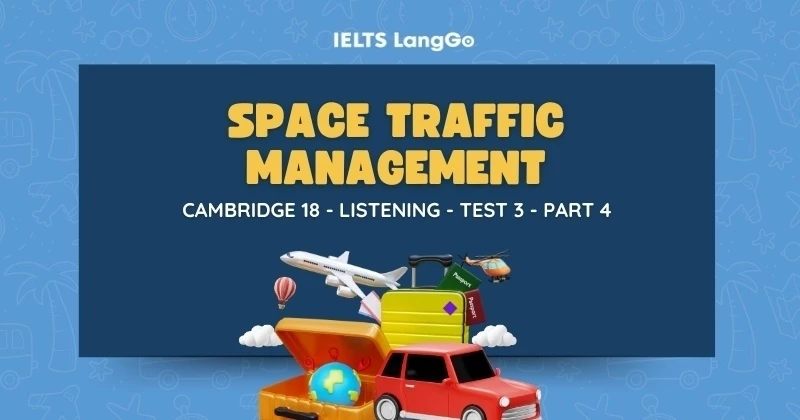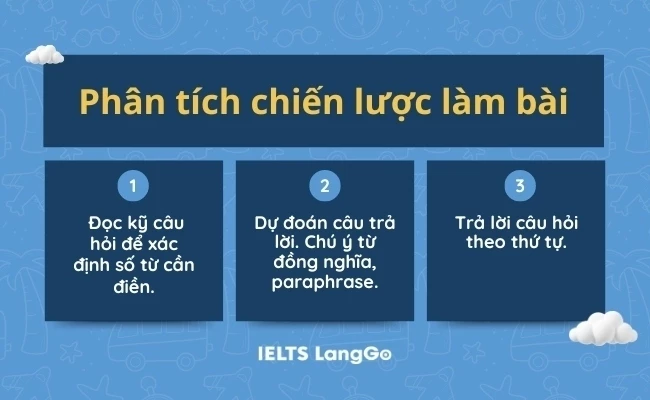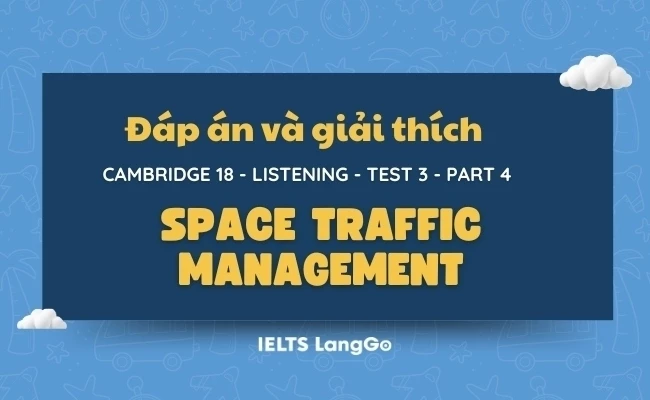


Phần phân tích đề và giải thích chi tiết cho đề Cambridge 18: Listening - Test 3 - Part 4: Space Traffic Management sẽ giúp các bạn hiểu rõ hơn cách làm các dạng bài tương tự nói chung, và dễ dàng chinh phục đề bài này nói riêng. Các bạn hãy tham khảo nội dung chi tiết ở bên dưới nhé!
Questions 31-40
Complete the notes below. Write ONE WORD ONLY for each answer.
Space Traffic Management
A Space Traffic Management system
is a concept similar to Air Traffic Control, but for satellites rather than planes.
would aim to set up legal and (31) _______________ ways of improving safety.
does not actually exist at present.
Problems in developing effective Space Traffic Management
Satellites are now quite (32) _______________ and therefore more widespread (e.g. there are constellations made up of (33) _______________ of satellites).
At present, satellites are not required to transmit information to help with their (34) _______________
There are few systems for (35) _______________ satellites.
Small pieces of debris may be difficult to identify.
Operators may be unwilling to share details of satellites used for (36)_______________ or commercial reasons.
It may be hard to collect details of the object’s (37) _______________ at a given time.
Scientists can only make a (38) _______________ about where the satellite will go.
Solutions
Common standards should be agreed on for the presentation of information.
The information should be combined in one (39) _______________
A coordinated system must be designed to create (40) _______________ in its users.

Phân tích đề bài và chiến lược làm bài
Bài tập của phần này bao gồm 10 câu, thuộc dạng Note Completion
Chiến thuật làm bài dạng Note Completion:
Bước 1: Đọc kỹ câu hỏi để xác định số từ cần điền. Trong đó có số từ được phép viết vào chỗ trống và tiêu đề. - Các bạn cần lưu ý ở đề này chúng ta chỉ được điền MỘT TỪ DUY NHẤT thôi nha.
Bước 2: Dự đoán câu trả lời. 2 loại thông tin chính bạn cần xác định về câu trả lời bao gồm:
Loại thông tin của câu hỏi: họ, địa danh, ngày tháng, số điện thoại, mã bưu điện, tỷ lệ phần trăm, giá cả,...
Loại từ bắt buộc: danh từ, tính từ, động từ.
Thông tin được dự đoán cũng có thể cụ thể hơn tùy thuộc vào ngữ cảnh nha.
Bước 3: Chú ý từ đồng nghĩa, paraphrase và những từ ngữ gây phân tâm.
Bước 4: Trả lời câu hỏi theo thứ tự.

Các bạn hãy tham khảo phần đáp án ở bên dưới để đối chiếu với kết quả của bàn thân sau khi thực hành. Và phần giải thích chi tiết sẽ giúp ích các bạn rất nhiều để hiểu rõ hơn về cách làm cũng như lối tư duy khi làm các bài Listening dạng Note Completion đó.
| 31 | technical | 36 | military |
| 32 | cheap | 37 | location |
| 33 | thousands | 38 | prediction |
| 34 | identification | 39 | database |
| 35 | tracking | 40 | trust |
Đáp án: technical
Key word trong câu hỏi: would aim to set up legal and 31 _____ ways of improving safety.
Cần tìm: tính từ miêu tả những phương pháp cải thiện độ an toàn.
Key word trong bài nghe:
In other words, a Space Traffic Management system. […]The aim of such a system would be to prevent the danger of collisions in space between the objects in orbit around the Earth. In order to do this, we’d need to have a set of legal measures, and we’d also have to develop the technical systems to enable us to prevent such accidents.
Giải thích: Nhân vật đề cập đến việc chúng ta cần có những phương pháp hợp pháp (legal measures) và hệ thống kỹ thuật (technical system) để tránh những tai nạn(prevent such accidents)
Đáp án: cheap
Key word trong câu hỏi: Satellites are now quite 32 _____ and therefore more widespread
Cần tìm: một tính từ dùng để mô tả về những vệ tiinh ở hiện tại.
Key word trong bài nghe: What are the problems in developing such a system? Well, for one thing, satellites are relatively cheap these days, compared with how they were in the past.
Giải thích: Sau khi đặt câu hỏi về những vấn đề trong việc phát triển hệ trống quản lý lưu lượng không gian(What are the problems in developing such a system?) - Nhận định đầu tiên được đưa ra là các vệ tinh hiện nay đang khá rẻ (satellites are relatively cheap these days)
Đáp án: thousands
Key word trong câu hỏi: (e.g. there are constellations made up of 33 _____ of satellites).
Cần tìm: lượng từ chỉ số lượng vệ tinh
Key word trong bài nghe: So there’s a lot more of them out there, and people aren’t just launching single satellites but whole constellations, consisting of thousands of them designed to work together.
Giải thích: Nhân vật giải thích về các tập về tinh (constellations) là tập hợp của hàng nghìn vệ tinh đơn lẻ (consisting of thousands of them)
Đáp án: identification
Key word trong câu hỏi: At present, satellites are not required to transmit information to help with their 34 _____ .
Cần tìm: danh từ chỉ một khía cạnh cần hỗ trợ qua việc truyền thông tin
Key word trong bài nghe: But in spite of this, one thing you may be surprised to learn is that you can launch a satellite into space and, once it’s out there, it doesn’t have to send back any information to Earth to allow its identification.
Giải thích: sau khi vệ tinh được phóng ra ngoài không gian, nó không cần truyền thông tin về Trái Đất (it doesn’t have to send back any information) để được cấp quyền định dạng (allow its identification)
Đáp án: tracking
Key word trong câu hỏi: There are few systems for 35 _____ satellites
Cần tìm: động từ hoặc tính từ liên quan đến các vệ tinh, trong đó có ít hệ thống dành cho đặc tính này.
Key word trong bài nghe: So while we have international systems for ensuring we know where the planes in our skies are, and to prevent them from colliding with one another, when it comes to the safety of satellites, at present we don’t have anything like enough proper ways of tracking them.
Giải thích: Chúng ta không có đủ những cách phù hợp (we don’t have anything like enough proper ways) đẻ theo dõi các vệ tinh (of tracking them)
Đáp án: military
Key word trong câu hỏi: Operators may be unwilling to share details of satellites used for 36 _____ or commercial reasons.
Cần tìm: danh từ chỉ mục đích sử dụng vệ tinh
Key word trong bài nghe: In addition, some operators may be unwilling to share information about the satellites they’ve launched. For example, a satellite may be designed for military purposes, or it may have been launched for commercial reasons, and the operators don’t want competitors to have information about it.
Giải thích: Một vệ tinh có thể được thiết kế vì mục đích quân sự (a satellite may be designed for military purposes), hoặc được phóng vì mục đích thương mại (commercial reasons).
Đáp án: location
Key word trong câu hỏi: It may be hard to collect details of the object’s 37 _____at a given time.
Cần tìm: danh từ chỉ một bộ phận của vật thể khó thu thập thông tin.
Key word trong bài nghe: And even if the operators are willing to provide it, the information isn’t easy to collect. Details are needed about the object itself, as well as about its location at a particular time – and remember that a satellite isn’t very big, and it’s likely to be moving at thousands of kilometres an hour.
Giải thích: Thông tin cũng không hề dễ thu thập. (the information isn’t easy to collect) Thông tin về vị trí của vật thể cần được thu thập ở một số thời điểm nhất định. (Details are needed about its location at a particular time)
Đáp án: prediction
Key word trong câu hỏi: Scientists can only make a 38 _____ about where the satellite will go.
Cần tìm: danh từ chỉ một thứ các nhà khoa học có thể làm
Key word trong bài nghe: We don’t have any sensors that can constantly follow something moving so fast, so all that the scientists can do is to put forward a prediction concerning where the satellite is heading next.
Giải thích: Tất cả những gì các nhà khoa học có thể làm là đưa ra dự đoán về hướng đi tiếp theo của vệ tinh. ( all that the scientists can do is to put forward a prediction concerning where the satellite is heading next.)
Đáp án: database
Key word trong câu hỏi: The information should be combined in one 39 _____
Cần tìm: danh từ chỉ nơi thông tin nên được tổng hợp.
Key word trong bài nghe: Then, as all this information’s collected, it needs to be put together so it can be used, and that will involve creating a single database on which it can be entered.
Giải thích: Thông tin nên được tổng hợp ở duy nhất 1 hệ thống dữ liệu (t needs to be put together […] a single database)
Đáp án: trust
Key word trong câu hỏi: A coordinated system must be designed to create 40 _____ in its users.
Cần tìm: danh từ, chỉ một điều gì đó giữa hệ thống tổ chức và người dùng
Key word trong bài nghe: To cope with this, we need to develop a system like the one I’ve described to coordinate the work of the numerous spacecraft operators, but it’s also essential that this system is one that establishes trust in the people that use it, both nationally and at a global level.
Giải thích: hệ thống tổ chúc cần xây dựng được lòng tin ở người dùng ( it’s also essential that this system is one that establishes trust in the people that use it)
Các bạn hãy thử sức làm bài trước khi đọc Transcript, sau đó sử dụng transcript ở những đoạn mình chưa nghe rõ và note xuống những từ vựng bạn cảm thấy áp dụng được trong giao tiếp nhé.
| In today’s astronomy lecture, I’m going to talk about the need for a system to manage the movement of satellites and other objects in orbit around the Earth. In other words, a Space Traffic Management system. We already have effective Air Traffic Control systems that are used internationally to ensure that planes navigate our skies safely. Well, Space Traffic Management is a similar concept, but focusing on the control of satellites. The aim of such a system would be to prevent the danger of collisions in space between the objects in orbit around the Earth. In order to do this, we’d need to have a set of legal measures, and we’d also have to develop the technical systems (31) to enable us to prevent such accidents. But unfortunately, at present we don’t actually have a Space Traffic Management system that works. So why not? What are the problems in developing such a system? Well, for one thing, satellites are relatively cheap these days (32), compared with how they were in the past, meaning that more people can afford to put them into space. So there’s a lot more of them out there, and people aren’t just launching single satellites but whole constellations, consisting of thousands of them (33)designed to work together. So space is getting more crowded every day. But in spite of this, one thing you may be surprised to learn is that you can launch a satellite into space and, once it’s out there, (34) it doesn’t have to send back any information to Earth to allow its identification. So while we have international systems for ensuring we know where the planes in our skies are, and to prevent them from colliding with one another, when it comes to the safety of satellites, (35) at present we don’t have anything like enough proper ways of tracking them. And it isn’t just entire satellites that we need to consider. A greater threat is the huge amount of space debris in orbit around the Earth – broken bits of satellite and junk from space stations and so on. And some of these are so small that they can be very hard to identify, but they can still be very dangerous. In addition, some operators may be unwilling to share information about the satellites they’ve launched. For example, a satellite may be designed for military purposes, (36) or it may have been launched for commercial reasons, and the operators don’t want competitors to have information about it. And even if the operators are willing to provide it, the information isn’t easy to collect. Details are needed about the object itself, as well as about its location (37) at a particular time – and remember that a satellite isn’t very big, and it’s likely to be moving at thousands of kilometres an hour. We don’t have any sensors that can constantly follow something moving so fast, so all that the scientists can do is to put forward a prediction concerning where the satellite is heading next. (38) —– So those are some of the problems that we’re facing. Let’s consider now some of the solutions that have been suggested. One key issue is the way in which information is dealt with. We need more information, but it also needs to be accessible at a global level, so we need to establish shared standards that we can all agree on for the way in which this information is presented. We already do this in other areas of science, so although this is a challenge, it’s not an impossible task. Then, as all this information’s collected, it needs to be put together so it can be used, and that will involve creating a single database (39) on which it can be entered. As we continue to push forward new developments, congestion of the space environment is only going to increase. To cope with this, we need to develop a system like the one I’ve described to coordinate the work of the numerous spacecraft operators, but it’s also essential that this system is one that establishes trust (40) in the people that use it, both nationally and at a global level. One interesting development … |
IELTS LangGo hy vọng phần giải thích chi tiết Cam 18: -Listening - Test 3 - Part 4: Space Traffic Management vừa rồi có thể giúp các bạn thuần thục hơn kỹ năng làm bài dạng Note Completion, cũng như giúp bạn mở rộng một số vốn từ, cấu trúc mới để đưa vào bài làm của mình. Với sự quyết tâm và kiên trì, chắc chắn các bạn sẽ sớm đạt được kết quả mình mong muốn, good luck!



ĐẶT LỊCH TƯ VẤN MIỄN PHÍ LỘ TRÌNH Săn ƯU ĐÃI lên tới 12.000.000đ